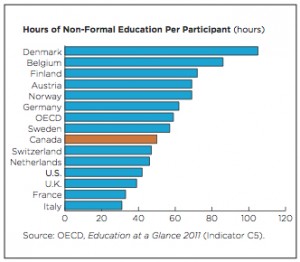Investing In People Key to Growth: Canada Lags in Non-formal Learning
By Christian Codrington, CHRP
The Organization for Economic Cooperation and Development broadly defines non-formal education as an “organized and sustained educational activity” that can “take place both within and outside educational institutions and caters to individuals of all ages.” It covers educational programs in adult literacy, life skills, work skills, on-the-job training, and general culture.
Much has been reported on the lack of job readiness of students completing post-secondary programming. However, employers play a key role in the skill development of Canada’s workforce. Organizations lament that one of their biggest challenges lie in skill shortages of their workforce and mismatches between demand and supply of labour. Yet, Canadian employers rank behind most of developed nations in the investment in their human capital and annual hours per employee on non-formal education.
Fewer Hours of Non-Formal Learning
 Canadian adults received 49 hours of job-related non-formal education in 2009 versus the OECD average of 59 hours. This represents less than half the hours received by adults in Denmark (105 hours), and well behind Belgium (86 hours), Finland (74 hours), Austria (69 hours), Norway (69 hours), and Germany (61 hours).
Canadian adults received 49 hours of job-related non-formal education in 2009 versus the OECD average of 59 hours. This represents less than half the hours received by adults in Denmark (105 hours), and well behind Belgium (86 hours), Finland (74 hours), Austria (69 hours), Norway (69 hours), and Germany (61 hours).
In its Learning and Development Outlook for 2014 The Conference Board of Canada’s reports that Canadian organizations spent an average of $705 per employee, compared with $688 per employee in 2010.
While this small increase lends to optimism, overall learning and development spending is down nearly 40 per cent from its historic high of $1,207 in 1993. Moreover, the average spend of US employers in 2010 was approximately 57 per cent higher than Canadian businesses at $1,071/employee. Over the past 20 years, spending has declined in both the public and private sectors and in organizations of all sizes.
Strong Learning Cultures Bring Rewards
These numbers are disturbing, as there is ample evidence to show that organizations with strong learning cultures realize higher levels of employee performance, customer satisfaction, and quality products and services compared to their competition. In an informal survey of HRMA membership, organizations of all sizes identified a number of practices that serve as a solid foundation, but noted they are often overlooked when it comes to investment decisions in learning and development.
A turn of perception is required to view the training budget as a vehicle to generate revenue, as opposed to a cost or reward; one local OD consultant decried that he has seen spa days coming under the leadership development line item.
Nonetheless, organizations are taking the first steps towards view training as an investment that will produce a return by asking key questions: why a certain intervention is needed, why this one over another and how will it contribute to long term growth or achieving our strategic priorities?
Evaluation of Learning Goals Key
Although difficult to fully apply, it is surprising to hear how few organizations perform Kirkpatrick’s Four-Level Training Evaluation Model to link training outcomes to business goals. It also critical to have proper oversight on individual approvals and expenditures to ensure spending contributes to organizational goals.
How an organization ensures training continues to be supported after the event is also critical. Organizations have found success when there are immediate opportunities to integrate the lessons into the learner’s role. Equally important is the role of post-training support to help learners integrate lessons. Trained mentors can be crucial in this area. The ongoing coaching allows organizations to tailor initiatives to organizational context which can change over time.
Organizations often struggle with developing training themselves or going to a third party provider. Generally speaking, the larger the numbers and the higher the frequency of training, organizations are most often pushed to develop and deliver the training themselves.
Some smaller organizations are taking a more cooperative approach to their learning investment. Resources are being pooled, sometimes through their business associations to purchase, develop and deliver the same training across multiple employers. And while the program has met its objectives for 2014/2015, initiatives like the BC Jobs Grant are expected to continue in place to offer employers significant resources to offset training and development costs.
Align Learning with Desired Results
However, one thing remains key and that is alignment. It is critical that the planning, content and coordination be anchored the organization’s desired behaviour competencies and outcomes. Truth be told, that up front analysis is often as important as the training itself—if not more so.
On a closing note, it is just as important for the HR, L&D and OD professionals to invest in themselves. While their ongoing CPD requirements are one consideration, the ability to effectively influence their organizations to invest in training is contingent on their ability to do the same for themselves.
Christian Codrington, CHRP, BBA is director of regulatory affairs and member value at HRMA.
(PeopleTalk Fall 2015)






